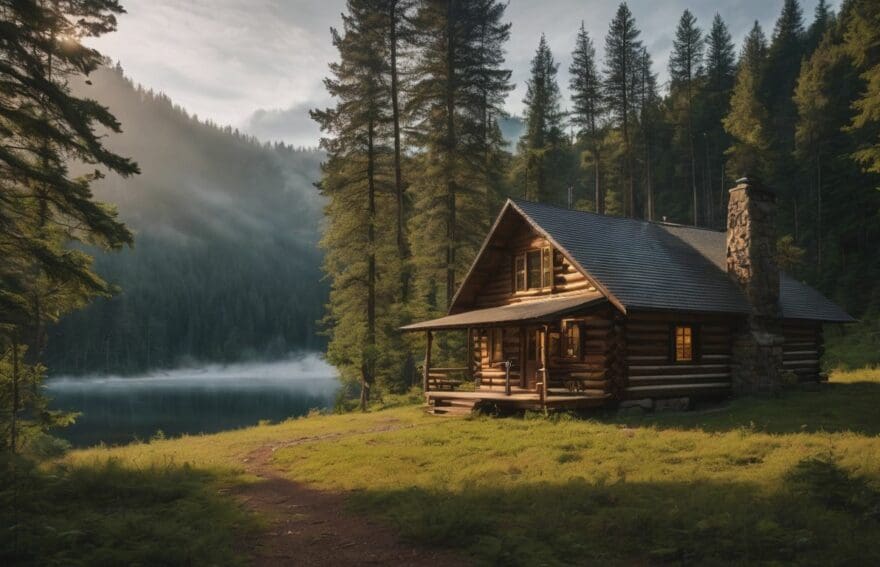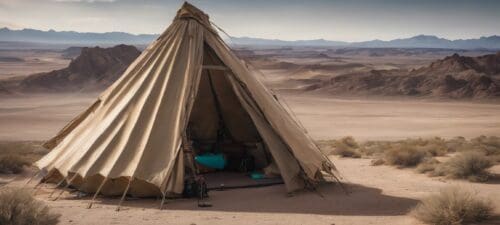Subsistence: Building and Surviving in the Wilderness

Updated On: November 08, 2025 by 
Have you ever found yourself yearning for a break from the relentless pace of urban existence, yearning to test your mettle against the elements as our ancestors once did? There’s something inherently human about this longing – after all, for countless generations before us, living in harmony with nature was not just a choice but a necessity.
This post is brimming with fundamental skills and age-old knowledge that will equip you to forge a life amidst the wilds. So let’s embark on this journey together and unlock the secrets to mastering wilderness survival, all under the vast canopy of stars.
What is Subsistence Building and Survival?
We see subsistence building and survival as the art of living off the land using only what nature provides. It’s about mastering skills such as shelter construction, fire creation, and sourcing water to stay alive in the wilderness.
This lifestyle dates back thousands of years when all humans foraged and hunted for their daily sustenance. Subsistence relies on a deep understanding of our environment, making use of renewable resources like wild plants and animals.
Embracing this way of life means becoming competent in various practices, from berry picking to timber cutting for your shelter needs. We take cues from ancient hunter-gatherers who not only used tools but also mastered fire to thrive in outdoor environments.
Our approach combines these time-honored techniques with modern bushcraft knowledge, ensuring we’re capable of self-reliance through primitive skills while enjoying an off-grid existence that connects us more deeply with nature.
Essential Skills for Subsistence Building and Survival
We will discuss essential skills for subsistence building and survival, including shelter building, fire starting, water sourcing and purification, foraging for food, and hunting and trapping.
These skills are crucial for thriving in the wilderness.
Shelter building
So, here we go. Building a shelter in the wilderness is essential for survival. The right shelter provides protection against the elements and wildlife, and it’s crucial for maintaining body temperature. Let’s dive into the crucial aspects of constructing a reliable shelter:
- Identify a suitable location that is elevated, dry, and away from potential hazards such as falling branches or flooding.
- Clear the area of any debris, rocks, or sharp objects to create a flat surface.
- Gather materials such as branches, leaves, and tarp to construct the frame and cover of the shelter.
- Utilise sturdy support structures like trees or rocks to secure the frame of your makeshift dwelling.
- Ensure that your shelter is well insulated to conserve body heat during cold weather by adding additional layers of foliage or insulating material.
- Test your shelter by spending time inside before relying on it for an extended period to ensure its sturdiness and functionality.
- Remember to consider local wildlife when building your shelter—this will prevent unwanted guests from joining you in close quarters.
Fire starting
When transitioning from shelter building to fire starting, it’s important to understand the significance of being able to create fire in a wilderness survival situation. Here are essential techniques and tools for mastering the art of fire starting:
- Friction Fire: Utilise traditional methods such as the bow drill or hand drill to create friction and generate heat, igniting dry tinder.
- Flint and Steel: Carry a flint and steel set as a reliable method for generating sparks to ignite tinder or char cloth.
- Fire Plow: Use a fire plow technique by rapidly rubbing a hardwood shaft against a softwood base to generate enough friction to produce an ember.
- Solar Ignition: Harness the power of the sun with a magnifying glass or convex lens to focus sunlight onto tender, creating heat and igniting the material.
- Char Cloth: Create char cloth by charring natural fibre cloth in a tin or metal container over an open flame, then use it to catch sparks and start a fire.
- Fire Starters: Pack waterproof matches, ferrocerium rods, or other commercial fire starters as reliable backup options for quickly igniting fires in adverse conditions.
- Tinder Gathering: Develop awareness of suitable natural materials such as dry grass, bark shavings, and small twigs that can be used as tinder for starting fires.
Water sourcing and purification
- Find a water source such as a stream, river, or lake. Look for clear flowing water as it is less likely to be contaminated.
- Use a piece of cloth or bandana to filter out larger particles from the water.
- Boil the water for at least one minute to kill any harmful bacteria and parasites.
- Alternatively, use water purification tablets or a portable water filter to make the water safe for drinking.
- Remember that staying hydrated is crucial, so prioritise finding and purifying water regularly.
Foraging for food
- Identify edible plants and fruits that are safe for consumption based on your environment and local knowledge.
- Utilise field guides or apps to accurately identify edible plants and avoid poisonous ones.
- Be knowledgeable about the seasons when certain plants are in bloom or fruit – bearing to optimise foraging efforts.
- Understand the different methods of preparation or cooking that may be required for different types of wild edibles.
- Apply sustainable practices when foraging to ensure the continued availability of food sources in the wilderness.
Hunting and trapping
Hunting and trapping are essential skills for subsistence building and survival in the wilderness. Here’s what you need to know:
- Constructing snares: Snares are simple traps designed to catch animals by the neck or leg as they pass through the loop.
- Setting up deadfall traps: These traps use a heavy object to crush the prey, triggering when the animal disturbs a trigger mechanism.
- Understanding animal behaviour: Knowing where to find game and recognising tracks and signs of animal movement is crucial for successful hunting.
- Using camouflage: Effective camouflage allows hunters to blend into their surroundings, increasing their chances of getting close to prey without being noticed.
- Crafting and using primitive weapons: Skills in making spears, bows, and arrows are vital for hunting game animals safely and effectively.
- Identifying edible plants for bait: Knowledge of wild edible plants that can be used as bait or lures can significantly improve trapping success without harming local wildlife.
Essential Items for Subsistence Building and Survival
When it comes to subsistence building and survival in the wilderness, having the right tools and equipment is crucial. From a reliable knife to water containers and fishing tools, these items can make all the difference in your ability to thrive in a wilderness setting.
Knife
A good quality knife is an indispensable tool for subsistence building and survival. It can be used for a variety of tasks, including cutting wood, skinning game, preparing food, and making other necessary tools.
A sharp knife is essential for safety and efficiency when navigating the wilderness. With the right skills and techniques, a reliable knife can make all the difference in successfully living off the land.
In a long-term wilderness survival scenario, having a durable knife that holds its edge is crucial for obtaining food and constructing shelter. When it comes to subsistence gameplay or real-life survival situations, understanding how to choose and maintain a knife becomes an important aspect of self-reliance in the wilderness.
Cordage
Cordage, such as rope and twine made from natural materials like plant fibers or animal sinew, is an essential item for subsistence building and survival. It can be used for lashing together shelter materials, creating snares for trapping game, constructing fishing tools, or forming makeshift tools in the wilderness.
Cordage also serves multiple purposes like repairing gear or making basic clothing. In a long-term wilderness survival scenario, knowing how to make and use cordage is a valuable skill that enhances self-sufficiency.
Moreover, cordage plays a crucial role in primitive living by enabling the creation of various essential items such as netting for fishing and securing shelters against harsh weather conditions.
Tarp or shelter material
When considering essential items for subsistence building and survival, tarp or shelter material plays a critical role in providing protection from the elements. A durable, waterproof tarp can be used to construct various types of shelters, such as lean-tos, A-frame shelters, or even improvised tents.
It provides a reliable barrier against rain, wind, and snow, enhancing the chances of staying dry and maintaining body temperature in challenging wilderness conditions. Additionally, having an understanding of how to efficiently set up a tarp shelter is vital for creating a safe and secure living space while living off the land.
In a long-term survival scenario or simulation game like Subsistence Gameplay that simulates challenges in the wilderness, mastering the use of tarp or shelter material is fundamental to establishing a sustainable living environment.
Water container
A water container is an essential item for subsistence building and survival in the wilderness. It provides a means to transport, store, and purify water, which is crucial for maintaining hydration and health.
When venturing into the wild, having a durable and portable water container allows you to collect and carry water from natural sources such as streams or rivers. Additionally, it enables you to boil water for purification or use purification tablets effectively.
Having a reliable water container ensures that you have access to clean drinking water throughout your wilderness survival experience. Furthermore, it allows you to efficiently gather and store enough water to sustain yourself during your time off the grid or in remote locations.
Fishing tools
Fishing tools are vital for obtaining food in a wilderness survival scenario. A sharp knife is essential for cutting and cleaning fish, while a sturdy line with hooks can be used to catch fish from nearby water sources.
In some cases, creating a simple fishing spear using available materials may also prove useful. Additionally, knowing how to make and set up basic fish traps can increase your chances of securing a sustainable food source.
Knowing how to use fishing tools effectively is crucial for subsistence living in the wild. Understanding the different techniques such as angling or setting up traps will greatly enhance your ability to provide sustenance for yourself in an off-grid environment.
Safety and Survival Tips for Subsistence Building
Always be prepared and stay calm in any survival situation. Know your environment and how to signal for help if needed. It’s important to have the skills, knowledge, and mindset to ensure your safety and survival when building and living in the wilderness.
Be prepared and stay calm
Prepare yourself mentally and physically for the challenges of subsistence building and survival in the wilderness. Familiarise yourself with the necessary skills, such as shelter building, fire starting, water sourcing and purification, foraging for food, and hunting/trapping techniques.
Stay calm under pressure; remember to assess your environment carefully before taking action. Knowing how to signal for help is essential in case of emergencies.
Stay prepared and proactive by understanding the surroundings where you will be living off the land. By knowing your environment well, you can better anticipate potential dangers or resources that may aid in your survival.
Know your environment
Before delving into subsistence building and survival, it’s crucial to know your environment. Understanding the terrain, climate, flora, and fauna of your surroundings is essential for sustainable living in the wilderness.
Take note of potential hazards such as poisonous plants or dangerous wildlife that may pose a threat to your safety. It’s also important to identify water sources and familiarise yourself with the best locations for shelter construction and food gathering.
Understanding your environment allows you to make informed decisions about where to set up camp, how to acquire resources sustainably, and how to stay safe in a natural setting. This knowledge not only enhances your chances of survival but also enriches the experience of living off the land in a harmonious way.
Know how to signal for help
In a wilderness survival situation, knowing how to signal for help can be a lifesaving skill. Using visual signals such as smoke from a fire or bright clothing can attract attention from potential rescuers.
Creating large symbols or messages on the ground using rocks, logs, or branches is also an effective way to communicate distress to passing aircraft or search teams. Additionally, utilising reflective surfaces like mirrors or shiny objects to flash sunlight towards nearby areas with higher visibility increases the chances of being noticed by rescue teams.
It’s essential for anyone in a survival scenario to understand and utilise these simple yet critical methods of signalling for help.
Knowing how to signal for help is crucial in any outdoor emergency situation. Understanding and employing visual signals effectively will significantly increase your chances of being located and rescued when stranded in the wilderness.
Conclusion
Mastering subsistence skills is crucial for wilderness survival. Understanding how to build shelters, start fires, source water, and gather food can be the difference between life and death.
With the right knowledge and tools, anyone can develop self-reliance in the great outdoors. Embracing these essential skills opens up a world of self-sufficiency and off-grid living possibilities.
FAQs
1. What are survival skills needed for living in the wilderness?
Survival skills for wilderness living include building a shelter, finding food and water, and knowing basic bushcraft to stay safe.
2. Can you explain homesteading and its role in self-sufficiency?
Homesteading means setting up a home that’s self-reliant, often off-grid, and using survival skills to live independently.
3. What should I know about creating a survival shelter in the wild?
When building a wilderness shelter, it’s vital to use natural materials around you effectively to protect from weather and wildlife.
4. How important is self-reliance when surviving off-grid?
Self-reliance is essential for off-grid living as it involves managing without outside help by learning various subsistence skills.
5. Does subsistence mean giving up modern comforts completely?
Not necessarily; while subsistence focuses on simplicity and making do with less, some people blend modern tech with traditional methods for comfort.









